The SNES Classic had a sterling assortment of games from Nintendo's 16-bit star console, but it's hardly all that system has to offer a modern audience. In each installment of this fortnightly feature, I judge two games for their suitability for a Classic successor based on four criteria, with the ultimate goal of assembling another collection of 25 SNES games that not only shine as brightly as those in the first SNES Classic, but have equally stood the test of time. The rules, list of games considered so far, and links to previous episodes can all be found at The SNES Classic Mk II Intro and Contents.
Episode XIX: Fiddle-Fodder
Candidate: Daft's Hameln no Violin Hiki
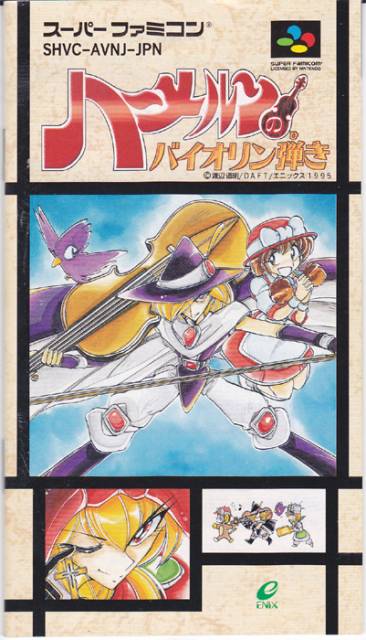
I have to admit, my hopes weren't high for this one. I planned out this whole feature at the start of the year, but the only other game developed by Daft that was on the list - the unusually anime adventures of Doc and Marty in Super Back to the Future II - has also become the lowest rated. That was their first game, however, and Hameln no Violin Hiki was their third. A studio can improve a lot in that time. There's also the concern that this was a licensed game: Hameln no Violin Hiki, or The Violinist of Hamelin, is a manga and anime about the titular melodic hero and a world of musically-named characters and locations (think Eternal Sonata, which I'm sure drew some inspiration from Hameln's naming conventions and its gingham-sporting selfless heroine). However, this is a rare case of a game adaptation preceding the anime adaptation: the game was released in 1995, and the anime OVA (and subsequent TV series) followed in 1996. That isn't to say that the game wasn't drawing from plans and character designs from the anime, but it does suggest that the developers weren't pressed to rush their game out to coincide with a massive multimedia push, which tends to be a major detriment for most video games, if not creative media in general.
Thankfully, despite all these portents, Hameln is actually a pretty decent puzzle-platformer with the familiar combination of clever mechanics and an appealing aesthetic. We've seen a procession of these games in this feature of late - Jelly Boy from the last episode, DoReMi Fantasy (Ep XIV), Holy Umbrella (Ep IX) - and I'm impressed at the level of depth these platformers demonstrated towards the end of the SNES's lifespan. It's a shame so few of them reached the United States, but I suppose even attractive 2D games would've had a hard time competing with all the cuboid nightmares of the fledgling 3D arena with how much the gaming press of the day was pushing the latter. As for Daft... well, after this it was wall-to-wall licensed K-1 games for PS1 and GBA followed by, finally, a Simple Series PS2 game about a mini-skirt detective whose clothes fall off when she gets hurt. Without playing either, I suspect Hameln was their high point.
Hameln's big innovation is how it plays up the comically dysfunctional relationship between the "legendary hero" (though he's more of a selfish jackass in reality) Hamel and his benevolent Good Samaritan follower Flute. Flute entreats Hamel to save her village by defeating the local monster army leader, Tuba, but Hamel only agrees if Flute joins him. It turns out Flute has the unusual ability to dress as various creatures and objects and obtain their powers. These kigurumi (as in, costumes, often of the oversized mascot variety) are doled out gradually throughout the game - there's sixteen in total, each providing unique utilities from a duck that can cross rivers to a curling puck used to smash walls - and are usually required to traverse levels. The game doesn't forget about previous power-ups either; the level design is built in such a way that you'll regularly need older abilities to proceed, or at the very least the player has various workable options for how they want to proceed. Flute herself is surprisingly sturdy - Hamel can pick her up and throw her at enemies and walls to destroy them even when she isn't in a kigurumi, and she'll do her best to follow behind unless Hamel tells her to stay put. Even with the amount of abuse and humiliation she deals with, the player is encouraged to keep her spirits up: there's a rare collectible that, if four are found, unlocks a bonus stage and Flute's condition at the end of a level can award up to two of these. In addition, Flute will earn you money if she defeats enemies while happy, though constant damage when she's in her agitated state will lose you money instead (unless you have a specific item to prevent this). Money is important in the game - at least one kirugumi can't be obtained any other way, and the most useful kirugumi in the game can be bought early - and you need a substantial pile of it to get anything from the store that isn't a single-use item.
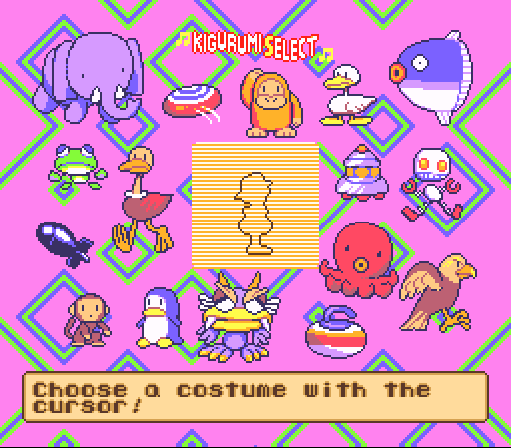
What's more, the game has a strict timer. It's often required that you move towards the exit than spend too long working on the game's environmental puzzles. Running out of time is the same as a death, and Hamel has a finite number of lives and loses any power-ups he's found if he falls. Flute can't die fortunately - there's the aforementioned incentive to keep her safe from harm, but it's not actually going to affect the outcome too much if she's in a foul mood due to your bumbling - but she can be left behind if she's stuck or you told her to wait, which can often grind progress to a halt. You learn to move fast and pick the best kirugumi on the fly, exploring dead-ends only if you have time to do so. I only ran out of time once, but there were a few close calls because I was wasting too much time trying different solutions out. It's a matter of taking the game's puzzles and obstacles cautiously to ensure Hamel and Flute's safety, but never dawdling.
Speaking of not dawdling, it's time for Hameln no Violin Hiki to pay the piper and pass through the P.O.G.S. process:
- Preservation: I keep saying it in this feature but it bears repeating that the modern market for Indie 2D platformers are full of games like Hameln, but very few if any are doing what it did. If it was released today on the Steam marketplace for $15, people would be all over it (though perhaps taking some exception to its comical abuse of a female sidekick - Flute gets it worse than even poor old Tails). 4.
- Originality: More so than even last week's Jelly Boy, the game's cribbing from David Crane's A Boy and His Blob with a constant companion that can change shape and help you traverse past spikes, water, lava, or whatever else might be in your path. It doesn't have the open-world aspect, but it does have a limited amount of commerce and permanent upgrades with Flute's kirugumi and a few accessories for Hamel. What's more, is that it does the escort thing - you can't move onto the next area unless Flute is with you - while sidestepping the usual frustrating accompaniments of faulty pathfinding and a far-too-vulnerable companion. 4.
- Gameplay: Hamel controls well enough, though he's limited to jumps and a ranged attack with his oversized violin. He's better suited for dealing with foes than Flute, who only has a few kirugumi that can attack enemies and is usually best left out of their reach. Fortunately, she's invulnerable when actually in a kirugumi, and they offer a wide range of forms with many other benefits. The time limit isn't quite as severe as I'm making it out to be - there's items you can find or buy to extend it if necessary - and I appreciate a platformer that requires me to think as often as react. 4.
- Style: It's a cute game with a visual style that can be expressive without necessarily needing giant sprites to convey those emotions. The way Flute gets huffy if you let her get damaged too much, or the incredulous look she gives you if you use her as a platform or pick her up, or the few non-animated cutaways between chapters to fill in their story all serve to accurately represent some degree of the original source's humor. Most of the music is classical stuff in the public domain; one of those easy shortcuts you're allowed to take when there's so much musical terminology in your game already. Alas, the game was not fan-translated too well, with sentences lacking cohesion or using incorrect terms (there's a character named after the German word for the bassoon and if you look that word up, you can see how a translator might unfortunately mistake it for a certain other one...), but I can't hold that against the original game. 4.
Total: 16.
Other Images:
The Nominee: Sensible Software's Cannon Fodder
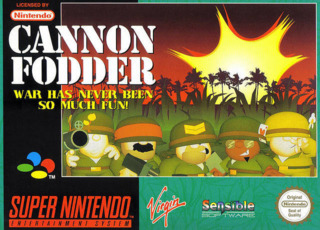
I swear this is the last of the obscure UK homegrown SNES games for this feature. There is one more UK-developed game on the list, but it's a well-known title that shouldn't be a surprise to anyone. Cannon Fodder is (the ironically named) Sensible Software's take on a gritty real-time war sim, but - as there is to everything they made - there's a certain streak of casual fun that helped to endear them to their original audience back on the Amiga and Atari ST, where most war sims tended to be the driest exercises imaginable. Primarily a mouse-driven game (it's compatible with the SNES Mouse peripheral), the goal is to explore a map and eliminate all enemy soldiers. That often means the buildings that spawn them as well, which require explosives and are very dangerous due to the unpredictable way chain reactions can spread. Between that and the way enemy soldiers can swarm around you, death tends to be very common and it's easy to get bummed out if you lose a soldier - who each have names and a rank determined by how many successful missions they've survived.
That's part of how Cannon Fodder works as an anti-war satire. Despite its tongue-in-cheek "war has never been so much fun" theme song and casually flippant gameplay, between losing soldiers and seeing their gravestones on Boot Hill (and once you've lost enough to cover that hill, it's a powerful image), or the sad music that plays when you see the list of soldiers who died in the mission, it's all affecting in a way you might not have anticipated. There's the somewhat sadistic way shot soldiers will occasionally sit there bleeding to death while screaming loudly, requiring one more shot to put them out of their misery (including your own, sometimes...). Even as the hill continues to fill with graves, the disposable units line up around it for the chance to serve their country, sometimes stretching off into the distance if you've not burned through too many. All it needs is an elderly Matt Damon asking everyone if he's a good person.
For as heavy as its themes might be, the gameplay couldn't be lighter. You direct your units around with one button and shoot in the direction of the cursor with the other. It's very important to be aware of one's surroundings - enemies can stream in from all directions - and study the map for where you need to go and where enemies might be lying in wait. Fortunately, you have an infinite supply of bullets, so you can simply let loose as enemies approach and hit them long before they can get you. Other cases, like blowing up enemy spawners, requires a certain amount of luck, preparation, or caution. For instance, you can split your unit up into individual soldiers, and have just one of them get close to a spawner and destroy it to protect the others from any unpredictable blowback - as comical as it is to watch, the way roofs tend to blow clean off and fly across the screen is bad news for anyone it eventually lands on. It's not an easy game, and death finds you frequently in the later levels as you get jumped by one nasty surprise after another, or are faced with overwhelming odds. As much as you want to keep your little guys safe to see how far they get can get promoted, it eventually becomes a forlorn hope; only the most cautious and well-prepared individuals can survive this war.
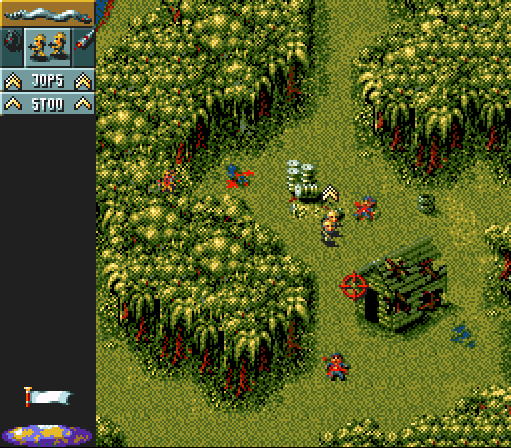
This wasn't Sensible's only game that made its way to the SNES. Were I not pressed for space and time in this feature, I might check out Sensible Soccer - the only soccer game I have any real affection for - and Mega-Lo-Mania, Sensible's more approachable and silly take on something like Populous or Civilization. Wizball and Wizkid are still two of my favorite games of all time due to their strangeness and irreverence, though unfortunately neither received console versions. In lieu of all these, Cannon Fodder is a fine introduction to the (so to speak) sensibilities of the developer and, try as Danny O'Dwyer might to sell the game's appeal to the skeptical Giant Bomb crew, a fair indication of the quality of their work.
And now, inevitably, it's time to unleash the P.O.G.S. of war:
- Preservation: Sensible were really ahead of the game when they came up with their approachable slants on previously more complex games. Since then, the industry has continued to move in the direction of user friendliness and streamlining systems and features which added little besides more key bindings to memorize. Of course, a few games like DOTA have gone the opposite direction, but I'm not going to humor them today. There's also the sad truth that the game's subtle anti-war message hasn't aged either; still as unfortunately apt today as ever. 4.
- Originality: A mouse-driven real-time tactical action game wasn't particularly common for the SNES for obvious reasons, so in that regard it stands in rare company. Even factoring in the wider European computer gaming market from which it hailed, though, Cannon Fodder split the difference between an action game and the more thoughtful tactical war games of the medium. It appealed to audiences young and old for this reason, and likewise punished those who dawdled thinking they had all the time in the world to think through their next action as much as it did those who rushed into every encounter with nary a forethought. There weren't a whole lot of games that could challenge its players that way. Still aren't. 5.
- Gameplay: The relentless guilt of losing named soldiers - pour one out for Jools and Jops - and demanding precision can make Cannon Fodder draining in even short doses, and I still take issue to how random it is to lose soldiers to flying debris whenever you blow something up, but even with these lapses of "fairness" it's an exceptionally well-made game even in its compromised SNES state, which had to drop the audio quality and make concessions due to the family-friendly guidelines set by Nintendo. Without the mouse controls, which I can't imagine a SNES Classic console would include, it's going to lose a lot of the speed and precision that's required for its later levels. 3.
- Style: SNES concessions aside, the graphics are perhaps the best in this version. It moves fast, even with lots of soldiers milling around, and there's something to Sensible's little sprites - who appear in Sensible Soccer and Mega-Lo-Mania as well - that's incongruously cute when they're creating bloody havoc. 4.
Total: 16.
Other Images:
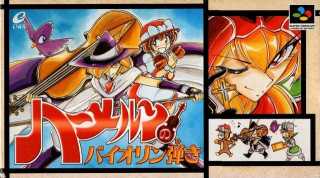














Log in to comment